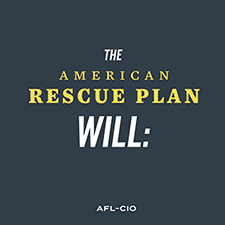The American Rescue Plan is a victory.
Like a lot of you, we’re also disappointed it doesn’t include a minimum wage increase this time. But that doesn’t change the fact that this bill will help people.
This bill gives people money. This bill helps schools reopen. This bill funds vaccine distribution.
Thousands of people called and wrote letters asking for help—for themselves and everyone else who has been struggling through the pandemic.
And help is coming.
We wanted to explain a few parts of the bill in plain English (we have a longer explanation on our blog). It’s a large bill, so there’s a lot of reading. But we hope this is useful.
In Solidarity,
Team AFL-CIO
What is the American Rescue Plan?
The American Rescue Plan is a COVID-19 relief bill that was passed in the House and Senate. It was signed by President Biden on March 11. It gives money directly to people who need it most. It also pumps money into our entire economy, from small businesses to state and local governments.
How much money will people get?
People will get different amounts based on their income and size of family. The Treasury Department and IRS are trying to get payments out this month. The IRS will use your most recent tax return to determine how much you will get and whether you’ll receive payment electronically or through the mail.
The maximum payment amount is $1,400 per person or dependent. Those who will receive full or partial benefits based on their income are:
- Single filers earning less than $80,000.
- Heads of households earning less than $120,000.
- Joint filers earning less than $150,000.
What about vaccines and PPE?
The bill dedicates billions of dollars to fighting COVID-19. There’s funding to distribute more vaccines. Aid for testing, contact tracing and personal protective equipment (PPE). And funds for expanding domestic production of PPE, vaccines and medical supplies.
How does it help students?
States will receive billions of dollars to help students of all ages. K-12 public schools will receive grants to reopen safely and support students as they recover from the effects of the pandemic.
Colleges and universities also will receive grants, of which at least half must be spent on emergency financial aid for students.
The bill also includes child tax credits, food aid and housing assistance to help caretakers provide children with everything they need to learn.

